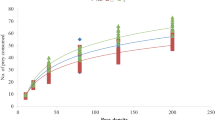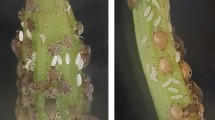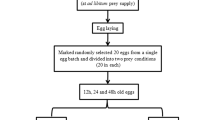Abstract
Female Aphidoletes aphidimyza confronts serious challenges from both aphid prey and conspecifics. These challenges constitute strong selective pressures on the predatory midge to have an adaptive oviposition strategy. We did laboratory experiments to investigate clutch size of A. aphidimyza in response to the aphid Rhopalosiphum padi (density and age) and the presence of conspecific eggs (density) and larvae (age) in aphid colonies. The results of our study show that A. aphidimyza female adjusts its foraging effort by assessing the quality of prey patches. The number of eggs laid increased in response to aphid density. However, patches consisting of older aphids received fewer eggs. The number of eggs laid decreased in response to the presence of conspecific eggs, and in response to the presence of 2-day old conspecific larvae. Our study reveals deterrent effects on A. aphidimyza oviposition decisions on clutch size in response to older aphids and the presence of more conspecific eggs and older larvae.




Similar content being viewed by others
References
Blümel S (2004) Biological control of aphids on vegetable crops. In: Heinz KM, van Driesche RG, Parrella MP (eds) Biocontrol in protected culture. Ball Publishing, Batavia, pp 297–312
Branquart E, Hemptinne J-L, Bauffe C, Benfekih L (1997) Cannibalism in Episyrphus balteatus (Dipt.: Syrphidae). Entomophaga 42:145–152
Chen H, Zhao J, Xie M, Wei S, Sun X, Wang J (1992) Tests on the effect of releasing Aphidoletes aphidimyza (Dip.: Cecidomyiidae) to control the aphid Myzus percicae in greenhpuses and plastic tunnels. Chin J Biol Control 8:97–100
Choi MY, Roitberg BD, Shani A, Raworth DA, Lee GH (2004) Olfactory response by the aphidophagous midge, Aphidoletes aphidimyza to honeydew from green peach aphid, Myzus persicae. Entomol Exp Appl 111:37–45
Dixon AFG (1998) Aphid ecology, an optimization approach, 2nd edn. Chapman & Hall, London
El Titi A (1972) Influences of prey density and morphology of the host-plant on the egg-distribution of the aphidophagous gall midge Aphidoletes aphidimyza (Rond.) (Diptera: Itonididae). Z Angew Entomol 72:400–415
El Titi A (1974) Auswirkung von der rauberischen Gallmucke Aphidoletes aphidimyza (Rond.) (Itonididae: Diptera) aur Blattlauspopulationen unter Glas. Z Angew Entomol 76:406–417
Evans EW (2003) Searching and reproductive behaviour of female aphidophagous ladybirds (Coleoptera: Coccinellidae): a review. Eur J Entomol 100:1–10
Havelka J, Ruzicka Z (1984) Selection of aphid species by ovipositing females and effects of larval food on the development and fecundity in Aphidoletes aphidimyza (Rondani) (Diptera: Cecidomyiidae). Z Angew Entomol 98:432–437
Havelka J, Zemek R (1999) Life table parameters and oviposition dynamics of various populations of the predacious gall-midge Aphidoletes aphidimyza. Entomol Exp Appl 91:481–484
Hemptinne JL, Magro A, Saladin C, Dixon AFG (2012) Role of intraguild predation in aphidophagous guilds. J Appl Entomol 136:161–170
Jandricic SE, Wraight SP, Gillespie DR, Sanderson JP (2013) Oviposition behavior of the biological control agent Aphidoletes aphidimyza (Diptera: Cecidomyiidae) in environments with multiple pest aphid species (Hemiptera: Aphididae). Biol Control 65:235–245
Jervis M (2005) Insect natural enemies, a practical perspective. Springer, the Netherlands
Kan E (1988) Assessment of aphid colonies by hoverflies. II. Pea aphids and 3 syrphid species; Betasyrphus serarius (Wiedemann), Metasyrphus frequens Matsumura and Syrphus vitripennis (Meigen) (Diptera: Syrphidae). J Ethol 6:135–142
Kan E (1989) Assessment of aphid colonies by hoverflies. III. Pea aphids and Episyrphus balteatus (de Geer) (Diptera: Syrphidae). J Ethol 7:1–6
Kareiva P (1990) The spatial dimension in pest–enemy interactions. In: Mackauer M, Ehler LE, Roland J (eds) Critical issues in biology control. Intercept Ltd, Andover, pp 213–227
Klingauf F (1967) Abwehr- und Meidereaktionen von Blattlüsen (Aphididae) bein Bedrohung durch Räuber und Parasiten. Z Angew Entomol 60:269–317
Losey JE, Denno RF (1998) The escape response of pea aphids to foliar-foraging predators: factors affecting dropping behaviour. Ecol Entomol 23:53–61
Lucas E (2005) Intraguild predation among aphidophagous predators. Eur J Entomol 102:351–364
Lucas E, Brodeur J (1999) Oviposition site selection by the predatory midge Aphidoletes aphidimyza (Diptera: Cecidomyiidae). Environ Entomol 28:622–627
Lucas E, Brodeur J (2001) A fox in sheep’s clothing: furtive predator benefit from the communal defense of their prey. Ecology 82:3246–3250
Mangel M (1987) Oviposition site selection and clutch size in insects. J Math Biol 25:1–22
Mansour MH (1975) The role of plants as a factor affecting oviposition by Aphidoletes aphidimyza (Diptera: Cecidomyiidae). Entomol Exp Appl 18:173–179
Marchan D, McNeil JN (2000) Effects of wind speed and atmospheric pressure on mate searching behavior in the aphid parasitoid Aphidius nigripes (Hymenoptera: Aphidiidae). J Insect Behav 13:187–199
Markkula M, Tiittanen K (1976) A method for mass rearing of Aphidoletes aphidimyza (Rond). SROP/wprs Bull 1976:183–184
Markkula M, Tiittanen K (1985) Biology of the midge Aphidoletes and its potential for biological control. In: Hussy NW, Scopes N (eds) Biological pest control, the glasshouse experience. Cornell University Press, Ithaca, pp 74–81
Markkula M, Tiittanen MK, Hamalainen M, Forsberg A (1979) The aphid midge Aphidoletes aphidimyza (Diptera, Cecidomyiidae) and its use in biological control of aphids. Ann Entomol Fenn 45:89–98
Messelink GJ, Bloemhard CMJ, Cortes JA, Sabelis MW, Janssen A (2011) Hyperpredation by generalist predatory mites disrupts biological control of aphids by the aphidophagous gall midge Aphidoletes aphidimyza. Biol Control 57:246–252
Morse JG, Croft BA (1987) Biological control of Aphis pomi (Hom.: Aphididae) by Aphidoletes aphidimyza (Dip.: Cecidomyiidae); a predator–prey model. Entomophaga 32:339–356
Ružicka Z, Havelka J (1998) Effects of oviposition deterring pheromone and allomones on Aphidoletes aphidimyza (Diptera: Cecidomyiidae). Eur J Entomol 95:211–216
R Development Core Team (2012) R: a language and environment for statistical computing. R Foundation for Statistical Computing, Vienna, Austria. ISBN 3-900051-07-0, URL http://www.R-project.org/
Scheirs J, De Bruyn L (2002) Integrating optimal foraging and optimal oviposition theory in plant-insect research. Oikos 96:187–191
Scholz D, Poehling HM (2000) Oviposition site selection of Episyrphus balteatus. Entomol Exp Appl 94:149–158
Sentis A, Lucas E, Vickery WL (2012) Prey abundance, intraguild predators, ants and the optimal egg-laying strategy of a furtive predator. J Insect Behav 25:529–542
Stewart HC, Walde SJ (1997) The dynamics of Aphis pomi de Geer (Homoptera: Aphididae) and its predator, Aphidoletes aphidimyza (Rondani) (Diptera: Cecidomyiidae), on apple in Nova Scotia. Can Entomol 129:627–636
Walde SJ, Murdoch WW (1988) Spatial density dependence in parasitoids. Ann Rev Entomol 33:441–466
Welsh AH, Cunningham RB, Donnelly CF, Lindenmayer DB (1996) Modelling the abundance of rare species: statistical models for counts with extra zeros. Ecol Model 88:297–308
Yukawa J, Abe J, Mizota K (2008) Improvement in the practical use of an aphidophagous gall midge, Aphidoletes aphidimyza (Diptera: Cecidomyiidae), in greenhouses. In: Mason PG, Gillespie DR, Vincent C (eds) Procceedings of the third international symposium on biological control of arthropods. Christchurch, New Zealand, pp 77–87
Acknowledgments
This study was supported by the Special Fund for Agro-Scientific Research in the Public Interest (201103002). We thank Xiaohong Li and Yi Zhou for their help in the experiments, Toshinori Okuyama for the help in data analyses, and all referees for their helpful and pertinent comments to the MS.
Author information
Authors and Affiliations
Corresponding author
Rights and permissions
About this article
Cite this article
Guo, H., Meng, L., Wang, Y. et al. Oviposition Behavior of the Predatory Midge Aphidoletes aphidimyza in Response to Aphid Patch Quality. J Insect Behav 27, 816–825 (2014). https://doi.org/10.1007/s10905-014-9473-1
Revised:
Accepted:
Published:
Issue Date:
DOI: https://doi.org/10.1007/s10905-014-9473-1




